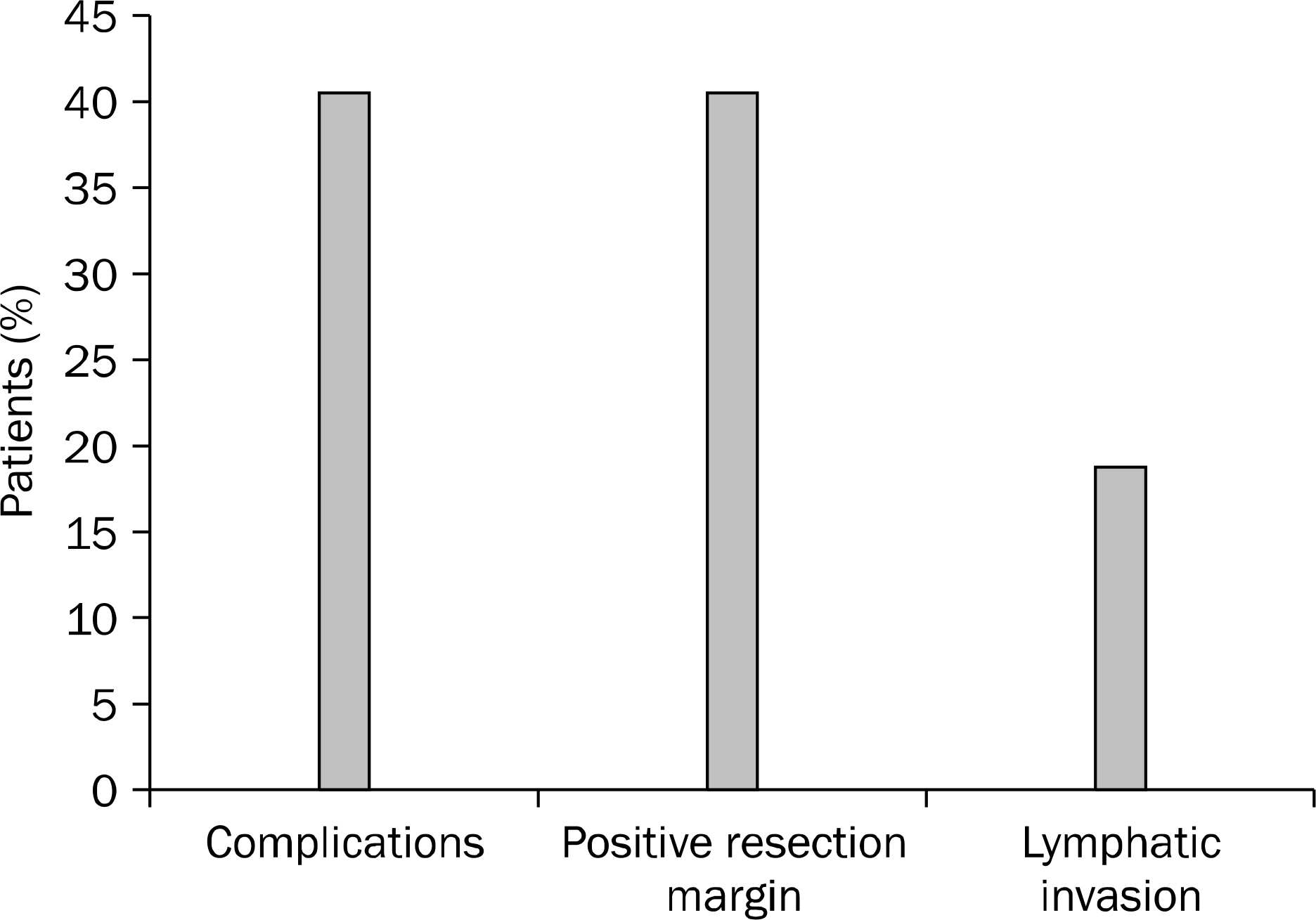Korean J Gastroenterol.
2012 Apr;59(4):289-295. 10.4166/kjg.2012.59.4.289.
Clinicopathologic Characteristics of Patients Who Underwent Curative Additional Gastrectomy after Endoscopic Submucosal Dissection for Early Gastric Cancer or Adenoma
- Affiliations
-
- 1Division of Gastroenterology, Department of Internal Medicine, Korea University Guro Hospital, Korea University College of Medicine, Seoul, Korea. gi7pjj@yahoo.co.kr
- KMID: 1364832
- DOI: http://doi.org/10.4166/kjg.2012.59.4.289
Abstract
- BACKGROUND/AIMS
Endoscopic submucosal dissection (ESD) has been widely performed. However, procedure related-complications and the risk of tumor recurrence are limitations. We analyzed the clinicopathological characteristics of patients who underwent curative additional gastrectomy (gastrectomy) after ESD.
METHODS
The clinical characteristics of cases underwent gastrectomy after ESD were retrospectively analyzed.
RESULTS
Between January 2002 and August 2010, 1,512 cases underwent ESD for early gastric cancer (n=511) or adenoma (n=1,001). Thirty-two cases (2.1%) underwent gastrectomy after ESD. Thirty cases (2.0%) were EGC and 2 cases (0.1%) were adenoma. Extended indication, larger tumor size and piecemeal resection were risk factors for gastrectomy after ESD. According to the causes of gastrectomy, 13 cases underwent gastrectomy due to complications (40.6%; bleeding in 9, perforation in 4), and 19 cases based on pathological results (incomplete resection in 13, lymphatic invasion in 6). In cases with incomplete resection, the rate of residual tumor and lymph node metastasis after gastrectomy was 69.2% (75% lateral margin, 60% deep and 75% both) and 7.7%, respectively. Three (50%) of the 6 cases with lymphatic invasion had lymph node metatstasis.
CONCLUSIONS
The causes of gastrectomy after ESD were the procedure-related complications, the incomplete resection and lymphatic invasion. For complete and curative ESD, endoscopists should try to minimize complications and determine the depth of invasion accurately before ESD.
MeSH Terms
Figure
Cited by 4 articles
-
Endoscopic Resection for Early Gastric Cancer beyond Absolute Indication with Emphasis on Controversial Issues
Yang Won Min, Jun Haeng Lee
J Gastric Cancer. 2014;14(1):7-14. doi: 10.5230/jgc.2014.14.1.7.Treatment Strategy after Incomplete Endoscopic Resection of Early Gastric Cancer
Sang Gyun Kim
Clin Endosc. 2016;49(4):332-335. doi: 10.5946/ce.2016.069.Endoscopic Submucosal Dissection for Early Gastric Cancers with Uncommon Histology
Gwang Ha Kim
Clin Endosc. 2016;49(5):434-437. doi: 10.5946/ce.2016.127.The Clinical Significance and Management of Noncurative Endoscopic Resection in Early Gastric Cancer
Jun Heo, Seong Woo Jeon
Clin Endosc. 2013;46(3):235-238. doi: 10.5946/ce.2013.46.3.235.
Reference
-
References
1. Lee HJ, Yang HK, Ahn YO. Gastric cancer in Korea. Gastric Cancer. 2002; 5:177–182.
Article2. Gotoda T, Yanagisawa A, Sasako M, et al. Incidence of lymph node metastasis from early gastric cancer: estimation with a large number of cases at two large centers. Gastric Cancer. 2000; 3:219–225.
Article3. Gunji Y, Suzuki T, Hori S, et al. Prognostic significance of the number of metastatic lymph nodes in early gastric cancer. Dig Surg. 2003; 20:148–153.
Article4. Oka S, Tanaka S, Kaneko I, et al. Advantage of endoscopic submucosal dissection compared with EMR for early gastric cancer. Gastrointest Endosc. 2006; 64:877–883.
Article5. Kim JJ, Lee JH, Jung HY, et al. EMR for early gastric cancer in Korea: a multicenter retrospective study. Gastrointest Endosc. 2007; 66:693–700.6. Bae JM, Kim SW, Kim SW, Song SK. Clinicopathological characteristics of patients who received additional gastrectomy after endoscopic resection due to gastric cancer. J Korean Surg Soc. 2010; 78:87–92.
Article7. Kim JJ, Kim BJ. Current status of endoscopic mucosal resection for early gastric cancer in Korea. Korean J Med. 2009; 76:291–295.8. Ono H, Kondo H, Gotoda T, et al. Endoscopic mucosal resection for treatment of early gastric cancer. Gut. 2001; 48:225–229.
Article9. Oda I, Gotoda T, Sasako M, et al. Treatment strategy after non-cu-rative endoscopic resection of early gastric cancer. Br J Surg. 2008; 95:1495–1500.
Article10. Manner H, Rabenstein T, May A, et al. Longterm results of endoscopic resection in early gastric cancer: the Western experience. Am J Gastroenterol. 2009; 104:566–573.
Article11. Kim HO, Choi WB, Shin JH, Yoo CH. An investigation of patients who have undergone curative gastrectomy after incomplete endoscopic mucosal resection with a diagnosis of early gastric xancer. J Korean Surg Soc. 2008; 74:187–191.12. Jung H, Bae JM, Choi MG, Noh JH, Sohn TS, Kim S. Surgical outcome after incomplete endoscopic submucosal dissection of gastric cancer. Br J Surg. 2011; 98:73–78.
Article13. Yasuda K. EUS in the detection of early gastric cancer. Gastrointest Endosc. 2002; 56(4 Suppl):S68–S75.
Article14. Lee TH, Cho JY, Chang YW, et al. Appropriate indications for endoscopic submucosal dissection of early gastric cancer according to tumor size and histologic type. Gastrointest Endosc. 2010; 71:920–926.
Article15. Cho YK, Cho JY, Jin SY, et al. Comparison of the cut direction between gross finding, streoscopic finding, and pathologic mapping of endoscopic submucosal dissection Specimen. Korean J Gastroenterol. 2010; 56:293–298.
Article16. Fujimoto A, Ishikawa Y, Akishima-Fukasawa Y, et al. Significance of lymphatic invasion on regional lymph node metastasis in early gastric cancer using LYVE-1 immunohistochemical analysis. Am J Clin Pathol. 2007; 127:82–88.
Article17. Ikeguchi M, Fukuda K, Oka S, et al. Micro-lymph node metastasis and its correlation with cathepsin D expression in early gastric cancer. J Surg Oncol. 2001; 77:188–194.
Article
- Full Text Links
- Actions
-
Cited
- CITED
-
- Close
- Share
- Similar articles
-
- Clinical significance of additional gastrectomy after non-curative endoscopic submucosal dissection for early gastric cancer: a retrospective single-center study
- Editorial: Additional Gastrectomy after Non-Curative Endoscopic Submucosal Dissection for Early Gastric Cancer
- Management Strategy of Non-curative ESD in Gastric Cancer: Curative Criteria, and the Critical Building Block for Determining Beyond It
- Endoscopic Submucosal Dissection in the Treatment of Patients With Papillary Early Gastric Cancer
- Treatment Strategies after Non-curative Endoscopic Resection of Early Gastric Cancer



